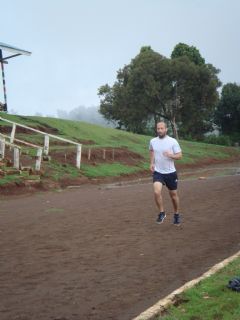In the airport on the way back down to London, I spent some time talking to 2012 Team USA Endurance Coach, Rose Monday & 800m runner & race winner, Erica Moore, who told me all about her training schedule back at the University of Tennessee. Erica was a two-time All-American back in 2010, earning the accolades in the 800m indoors & the 400m hurdles during the outdoor track season. This season is the first that Erica plans to compete extensively out of the USA & she is definitely excited to travel, after spending her childhood in Indiana, USA, which is apparently not the most cosmopolitan part of the world!!!
When I arrived back into London, I pulled on my running shoes & headed onto the canal to do an hour run. I was pleased with my pace & the work that I have been putting into my running style, with the aid of my new coach, Rob Denmark is progressing well. Armed with a programme in the gym & sessions on the track, I am trying to improve my cardiovascular base & at the same time run with a more forefoot biased gait. The change in style demands a lot from my calves & I would recommend that you should only move to this pattern if you are able to put the time into constructing a sensible programme of progression, with conditioning work in the weights room, otherwise injuries are likely to occur.
Needless to say that yesterday morning, my calves were screaming with DOMS (delayed onset muscle soreness, or EIMS, exercise induce muscle soreness as it is also referred to). The treatment & prevention of DOMS is a hotly disputed topic, with many athletes jumping into an ice bath at the first whiff of an exercise bout that may result in the symptoms. However, my former colleague at the FA, Dr Sam Erith & former lecturer at Loughborough University, Dr David Bailey, published some research to demonstrate that, whilst ice baths do reduce the symptoms of DOMS, they also dampen the adaptation to the training that caused the DOMS in the first place. As a result if you are looking to benefit from the training you are doing, ice baths are not the answer...however, if you are looking to recover from a competition bout to be able to race/play again the following day, then ice bath use in this circumstance is far more appropriate.
One of the main issues with establishing how severe the DOMS is following a specific bout of training, is that obtaining objective data on the severity of the muscle damage is difficult. Most studies I have read previously either use a visual analogue scale (VAS) to report severity of symptoms (but this is subjective) or have taken muscle biopsies & blood samples to establish levels of myofibre proteins such as creatine kinase. However, in addition to being rather invasive, some authors have shown that these are not always reliable markers of muscle damage.
However, I have just read & watched (yes, this is the first video review I have seen on-line) an interesting article, published by Al-Nakhli et al, looking at the use of thermal infra-red imaging to detect DOMS. The study used thermal infra-red imaging to detect changes in skin temperature between pre- & 24/48 hour, post-exercised arms (biceps brachii) in 41 subjects, following a resisted isometric elbow flexion exercise. The authors also took blood samples to measure myoglobin concentrations in the blood, in addition to recording visual analogue scale scores, to establish pain ratings in relation to the DOMS.
The results indicated that the thermal infra-red imaging was a valid tool for detecting DOMS, particularly in the first 24 hours post-exercise, with significant changes in skin temperature being observed in the exercised arm but no changes being recorded in the non-exercised arm of the same subject. Results on day two also corresponded with increased VAS pain scores recorded on the same day.
To read the study protocol, click on the link below:
To view the video review, click on the link below:
This is an interesting study, for sure but with regards practical use in the field, I see several practical issues - but you'll see what I mean once you view the video!!! I am also not sure what practical benefit this data would have in the field, as the athlete's perception of pain is most likely to be the guiding factor given the influence this will have on subsequent activity participation.

